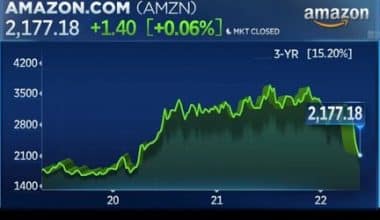The best index funds can help you generate wealth by diversifying your portfolio and lowering your expenses on transaction fees. In general, index funds are a good choice since passive fund management produces superior long-term returns than active fund management. This article covers some of the best index funds in for Beginners and Pros. It also lists the top total stock market index funds as of June.
The Best Index Funds in 2023
To choose an index fund, you must first determine which stock market index you wish to follow. After which, you’d need to locate the fund that has the most closely correlated performance with that index.
For the most part, the fund’s expense ratio, which represents the annual management fee, should be modest. Here are our picks for the eight best index funds based on those factors.
#1. Fidelity ZERO Large Cap Index Fund (FNILX)
Investing in S&P 500 index funds is the closest to a sure thing when it comes to building wealth over time. The ZERO Large Cap Index Fund from Fidelity looks a lot like an S&P 500 index fund. It monitors indexes of just above 500 large-cap companies in the United States. However, it avoids paying pricey licensing fees to the S&P’s parent firm because it isn’t an official S&P 500 index fund. This allows Fidelity to offer the ZERO Large Cap Index Fund with zero investment expenses. In other words, the ZERO Large Cap Index Fund has a 0% expense ratio. It also has no minimum investment requirement, making it an excellent option for new investors.
In 2020, the fund, which is benchmarked on the Fidelity U.S. Large Cap Index, generated a total return of 20.05 percent. In comparison, the S&P 500 returned 17.4 percent over the same time frame.
#2. Schwab (SWPPX)
With an expense ratio of 0.02 percent, Schwab’s S&P 500 Index Fund is about the cheapest official S&P 500 index fund you’ll find. That means you’ll pay just $0.20 for $1,000 invested each year. There’s also no minimum investment.
Furthermore, your returns are nearly identical to the S&P 500 index because the investment fee is so little.
#3. Vanguard Growth Index Fund ETF (VUG)
The Vanguard Growth ETF (VUG) is a good choice if you can afford to take on more risk in exchange for bigger returns. The fund is based on the CRSP US Large Cap Growth Index, which is similar to the S&P 500 Growth Index. It invests in each of the 255 large-cap growth equities in the United States.
Furthermore, tech equities are heavily represented, contributing for 47 percent of the fund’s holdings. Energy and utility sectors, on the other hand, account for only 0.3 percent.
The VUG has a small expense ratio of 0.04 percent. The fund’s five-year average annual return before taxes was 20.34 percent as of Dec. 31, 2020, compared to 15.19 percent for the Vanguard S&P 500 ETF.
Read Also: High Dividend Mutual Funds: Best 2023 Options (Updated)
#4. SPDR S&P Dividend ETF (SDY)
The SPDR S&P Dividend ETF is a leading index product for income investors. The S&P High Yield Dividend Aristocrats Index, which measures 113 of the highest-dividend-yielding firms in the S&P Composite 1500 Index, all of which have grown their dividend payments for at least 25 years, serves as the benchmark for the dividend-weighted fund.
As of March 15, 2021, this fund’s 12-month dividend yield was 2.52 percent; far higher than the S&P 500’s 1.46 percent. The expense ratio of 0.35 percent is a little higher than the other three funds we looked at.
#5. Vanguard Real Estate Index Fund ETF (VNQ)
With an expense ratio of 0.12 percent, the Vanguard Real Estate ETF (VNQ) is a good low-cost alternative if you wish to invest across the real estate market. With $33.7 billion in assets, it is by far the largest and one of the best real estate index fund.
The MSCI US Investable Market Real Estate 25/50 Index, which broadly tracks the US real estate market, serves as its benchmark. Although there are a few real estate management and development companies in the index, it is primarily made up of equity REITs, which own and operate income-producing commercial real estate. The fund’s 12-month dividend yield (dividend paid as a percentage of share price) was 3.8 percent as of February 2021.
#6. Vanguard Russell 2000 ETF (VTWO)
Small-cap companies, defined as those with a market valuation of $300 million to $2 billion, have greater growth potential than large-cap companies, but they also carry higher risk. For investors looking to take advantage of that potential upside, the Vanguard Russell 2000 ETF (VTWO), which tracks the Russell 2000 index, is an excellent place to start. The fund owns shares in 2,081 small and mid-cap firms with a market capitalization of $2.8 billion.
This index fund’s biggest concentration, as of Jan. 31, 2021, was in healthcare firms (20.7 percent), followed by consumer discretionary goods companies (16.2 percent), and industrials companies (14.6 percent ). The fund’s expense ratio is relatively modest, at 0.1 percent.
Furthermore, with a total return of 20.2 percent in 2020, the Vanguard Russell 2000 ETF outperformed the S&P 500.
With a total return of 28.89 percent in 2020, the iShares MSCI China ETF (MCHI)— which more or less matches China’s counterpart of the S&P 500— surpassed the S&P 500. It has a cost ratio of 0.59 percent, which is slightly lower than the average China ETF expense ratio of 0.7 percent, according to ETF.com.
Although diversifying your portfolio with international exposure is important, and China’s development potential is enormous, there are also substantial hazards to investing in the world’s second-largest economy. For starters, Chinese accounting standards are insufficient, trade disputes are a possibility, and the recovery from the pandemic is questionable.
But while Chinese equities rose in 2020, it’s worth noting that they’ve underperformed in the preceding decade when compared to US markets.
#8. The Schwab Emerging Markets Equity ETF (SCHE)
The Schwab Emerging Economies Equity ETF (SCHE) may be a suitable option if you want portfolio exposure to high-growth emerging markets but don’t want your risk concentrated in a single economy. Its expense ratio is under 0.11 percent, and it tracks the FTSE Emerging Index, which is a collection of large- and mid-cap equities from more than 20 developing nations. The fund has 1,535 holdings, with China, Taiwan, India, Brazil, and South Africa having the highest concentrations.
Keep in mind that, traditionally, emerging markets have lagged U.S. stocks. The Schwab emerging market funds have achieved total returns of just under 50% in recent decades, compared to more than 260 percent for the S&P 500. However, given that developing countries account for roughly 85% of the world's population, long-term investors who are fine with volatility should carefully consider investing in this fund.
As of June 2021, the Best Index Funds are;
The following list covers S&P 500 index funds from a range of companies, as well as some of the lowest-cost funds available on the open market. One of the most crucial aspects in your total return when investing in an index fund like this is the cost. Two mutual funds and three exchange-traded funds are included:
Read Also: American Mutual Funds: 7+ Top Outperforming Picks (+ Quick Tips)
#1. Fidelity ZERO Large Cap Index (FNILX)
The Fidelity ZERO Large Cap Index mutual fund is part of Fidelity’s effort towards no-expense-ratio mutual funds, hence the ZERO designation. Although the fund does not formally track the S&P 500, it does follow the Fidelity U.S. Large Cap Index, but the distinction is purely academic. The fundamental difference is that Fidelity doesn’t have to pay a licensing fee to use the S&P name, which keeps costs down for investors.
The expense ratio is 0%. That means that every $10,000 invested will cost you nothing in the long run.
#2. Vanguard S&P (VOO)
The Vanguard S&P 500, as its name suggests, tracks the S&P 500 index and is one of the largest funds on the market, with hundreds of billions in assets. This exchange-traded fund (ETF) was launched in 2010 and is supported by Vanguard, one of the largest investment companies in the world.
Its expense ratio is 0.03 percent. That means that every $10,000 invested will cost you $3 per year.
#3. SPDR S&P (SPY)
The SPDR S&P 500 ETF is the granddaddy of all exchange-traded funds, having been established in 1993. It was instrumental in launching the current wave of ETF investing. It’s one of the most popular ETFs, with hundreds of billions in assets. The fund is sponsored by State Street Global Advisors, another industry heavyweight, and it tracks the S&P 500 index.
Its expense ratio is 0.09 percent. That means that every $10,000 invested will cost you $9 per year.
The iShares Core S&P 500 ETF is a fund sponsored by BlackRock, one of the world’s largest fund companies. This iShares fund is one of the largest ETFs, and it tracks the S&P 500, just like these other large funds.
Furthermore, with a start date of 2000, this fund is another long-term player that has closely followed the index throughout time.
Its expense ratio is 0.03 percent. This means that every $10,000 invested will cost you $3 per year.
#5. Schwab S&P 500 Index Fund (SWPPX)
With tens of billions in assets, the Schwab S&P 500 Index Fund is on the lower side of the giants on this list, but that’s not really a problem for investors. This mutual fund has a track record dating back to 1997, and it’s sponsored by Charles Schwab, one of the most reputable names in the industry. The fund’s ultra-low expense ratio reflects Schwab’s commitment to providing products that are beneficial to investors.
The expense ratio is 0.02 percent. That means that every $10,000 invested will cost you $2 each year.
The Best Index Funds for Beginners 2023
If you’re new to investing, a brokerage business that provides index funds can be a good place to start. Reason being that they often provide some helpful services, such as investment advice, which can help you choose an index fund. Here are a few brokers who provide low-cost index funds with no minimum account balance and low commissions:
- J.P. Morgan
- Vanguard
- E-Trade
- Ellevest
- Firstrade
- TD Ameritrade
- Merrill
- Fidelity
- Charles Schwab
Best Total Stock Market Index Funds
Investing in a total stock market index fund is a simple and inexpensive approach to diversify your equities exposure in the United States. In most cases, the funds have extremely low expense ratios. However, not all of the options are the same, since they use different underlying indexes and methodology to replicate the stock market in the United States.
Total stock market index funds are also being tax-efficient, making them a good option for a taxable brokerage account.
What Are Total Stock Market Index Funds and How Do They Work?
When it comes to index fund investment, there is no single definition of the “whole US stock market.” Different indexes are used by different funds to build their portfolios. That’s a massive job as rival funds use a variety of tactics to complete it.
Index funds are low-cost investment instruments that mimic the performance of a benchmark index. Total market index funds, on the other hand, are based on indexes that represent the whole US stock market. These include the Wilshire 5000, the CRSP US Total Market Index, and the Russell 3000. The indices—and thus the funds based on them—have minimal turnover, which helps to keep capital gains taxes low.
Note: This list does not include funds that track the S&P 500 index in this list. The S&P 500, while undoubtedly the most well-known U.S. equity index, excludes most U.S. stocks—it is, by definition, confined to the 500 largest U.S. public firms.
Top Total Stock Market Index Funds as of June 2021
The following are some of the best total stock market index funds as of June 2021;
#1. Schwab Total Stock Market Index (SWTSX)
The Schwab Overall Stock Market Index Fund attempts to track the total stock market in the United States as measured by the Dow Jones U.S. Total Stock Market Index. As of January 2021, it had net assets of more than $14 billion. There is also no requirement for a minimum investment, with its net expense ratio hanging at only 0.03 percent. As of December 31, 2020, its trailing twelve-month (TTM) yield was 1.62 percent.
- Dow Jones U.S. Total Stock Market Index is used as a tracking index.
- Investment Requirement: None
- The company was founded in 1999.
- 3,227 holdings
#2. Vanguard Total Stock Market Index Fund (VTSAX)
The CRSP US Total Market Index is tracked by the Vanguard Total Stock Market Index Fund. As of the end of 2020, it had more than $1.1 trillion in net assets. It does, however, need a minimum commitment of $3,000, unlike the other funds on our list. It’s worth noting that an identical ETF version of the fund—ticker VTI —has no minimum investment requirement. The expense ratio of the fund is 0.04 percent. As of December 31, 2020, its trailing twelve-month (TTM) yield was 1.41 percent.
- CRSP US Total Market Index is used as a tracking index.
- $3,000 is the minimum investment.
- The company was founded in the year 2000.
- 3,634 holdings
#3. Fidelity ZERO Total Market Index Fund (FZROX)
For various reasons, the Fidelity ZERO Total Market Index Fund is unlike any other. For starters, it is the only fund on our list without an expense ratio. However, this does not make it free, as shareholders must pay other fees, such as the fund’s transaction costs.
Secondly, the fund tracks the proprietary Fidelity U.S. Overall Investable Market Index to try to replicate the total market. This is not the same index as the Fidelity Total Market Index Fund, as you can see below.
Finally, with an inception date of August 2, 2018, FZROX is the newest fund on our list. As a result, it lacks 5- and 10-year performance statistics. It had a one-year performance of 20.50 percent. The fund currently manages $7.5 billion and has a trailing twelve-month (TTM) yield of 1.27 percent.
- Fidelity U.S. Total Investable Market Index is the tracking index.
- Investment Requirement: None
- Inauguration: 2018
- 2,442 total holdings
#4. Fidelity Total Market Index Fund (FSKAX)
The Fidelity Total Market Index Fund looks similar to FZROX on the surface, but it follows a different index, the Dow Jones U.S. Total Stock Market Index. It tracks 1,000+ more companies than the FZROX while maintaining an extremely low expense ratio of 0.015 percent.
Furthermore, there is no minimum investment.
The fund’s trailing twelve-month (TTM) yield was 1.45 percent, which was significantly higher than FZROX.
- Dow Jones U.S. Total Stock Market Index is used as a tracking index.
- Investment Requirement: None
- The company was founded in 1997.
- Holdings: 3,532
#5. Vanguard Russell 3000 Index Fund (VRTTX)
Vanguard’s Russell 3000 Index Fund is designed specifically for 401(k) accounts and other workplace retirement plans. It gives investors inexpensive exposure to the Russell 3000, with no minimum investment requirement. The fund is inadequate by Vanguard’s standards, at just $1.9 billion in net assets. Also, the fund’s recent trailing twelve-month (TTM) yield comes in at 1.31 percent
- Tracking Index: Russell 3000 Index
- Investment Requirement: None
- Inception: 2010
#6. Wilshire 5000 Index Fund (WFIVX)
The Wilshire 5000 Index Fund aims to mirror the Wilshire 5000 index, which bears its name. The index has around 3,500 stocks. Furthermore, with little over 1,700 holdings, the fund aims to replicate the index.
However, while the fund is the most expensive on our list, with a $1,000 minimum investment, it has a very competitive 5-year record. The Wilshire 5000 Index Fund is a tiny fund, having net assets of around $200 billion. Its trailing twelve-month (TTM) yield was 0.96 percent at the time of this writing.
- Wilshire 5000 Index is its tracking index.
- $1,000 is the minimum investment.
- The company was founded in 1999.
- There are 1,735 holdings in all.






